Page 7 of 9
Re: Max Anderson
Posted: Sun Jun 12, 2022 10:09 am
by Max Anderson
Small Pearls at East Budleigh common
I went for a walk through Bicton and East Budleigh common in East Devon this weekend, hoping to stumble across some Silver-studded Blues. Unfortunately, I had no luck, but the wind certainly didn't help. I did, however, manage to spend a good few hours admiring Small Pearl-bordered Fritillaries, which are in very good numbers here.
When I first arrived, in the late afternoon, I watched as one set up to roost on some grass. I walked on to find 40-50 others all soaking up the last of the sunshine, perching on lower spots in the long vegetation, and finally beginning to find roosting spots.
On my way back, I checked the same individual on the grass stalk and found that another had joined.
Re: Max Anderson
Posted: Sun Jun 12, 2022 11:03 am
by Matsukaze
I love that penultimate photo, of the fritillaries in the landscape.
Re: Max Anderson
Posted: Sun Jun 12, 2022 3:16 pm
by Wurzel
Fantastic set of images Max - I especially like the 'stained glass' shots - I'm a sucker for those always



Have a goodun
Wurzel
Re: Max Anderson
Posted: Mon Jun 13, 2022 7:26 pm
by David M
I really like the different manner in which you photograph your butterflies, Max.
Some beautiful SPBF shots there, with habitat context and wonderfully rich colours.
First class.

Re: Max Anderson
Posted: Sat Aug 06, 2022 9:45 pm
by Max Anderson
Thanks all for the kind comments on the photos, much appreciated!
Re: Max Anderson
Posted: Sat Aug 06, 2022 10:05 pm
by Max Anderson
Silver-studded blues
After seeing some other posts of SSBs from Iping common earlier in the year, I was tempted to head over when timing permitted. In mid-June, I was due to head to Ecuador for work, and my window of opportunity was slim. Fortunately, I managed to find some time in the afternoon after doing some work at Knepp, and continued along the road west to Iping common.
I managed to count 29 males and 7 females, including 3 mating pairs.
There were a good number of fresh males appearing, and the usual bouts of entertaining aerial drama.
The in-flight shots really highlight the dexterity of the wings.
Re: Max Anderson
Posted: Sun Aug 07, 2022 6:00 pm
by Wurzel
Those in flight shots are stunning Max



Really shows up the unusual shapes the wings form

Have a goodun
Wurzel
Re: Max Anderson
Posted: Mon Aug 08, 2022 1:21 pm
by Max Anderson
Thanks Wurzel - Yes, I agree about the wing shapes, really bizarre. It also highlights the precision they have in flight, something that's very difficult to gauge otherwise.
Re: Max Anderson
Posted: Tue Aug 09, 2022 9:25 am
by Max Anderson
Small Blue
I've been following some Small Blues at a local site, trying to get a better understanding of their ecology as larvae. Despite the site only being around 1 acre in size, you can reliably find tens, if not hundreds of small blues. Eggs are easy to spot, as they tend to be quite conspicuous, but it can be difficult to photograph them clearly, given the contrast against the calyces, which are very hairy, and often obscure the eggs. They're almost exclusively laid singularly on the calyx, with some further down towards the base, which makes finding them slightly more difficult. On occasion, the eggs can also be found on the underside of the sepals, which can be easier to photograph.
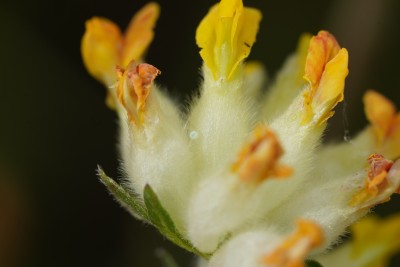
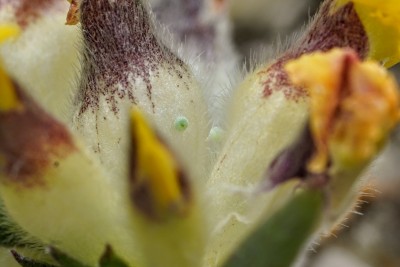
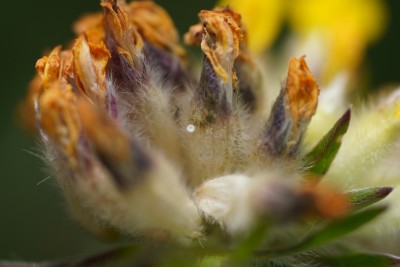
Upon emerging, the caterpillars enter the calyx and start feeding on the developing flowers (or seed pods, depending on the generation). It's occasionally possible to see the silhouetted body of the larva through the calyx, but not always easy to achieve. The larvae often move to adjacent flowers to continue feeding, and will eventually become too big to fit inside the calyx. At this point, they are in the 4th larval stage, and will be easiest to find, nestled in between calyces, or occasionally found moving around the cluster of flowers.
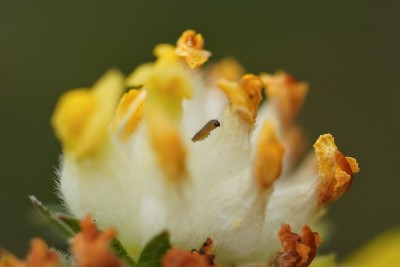
- L2
Unfortunately, I have been unsucessful in locating pupae. I suspect that in the wild, the larvae travel down the stem and pupate on or near the ground, likely attaching themselves to a leaf. I'd be interested to know if anyone else has had any success in finding pupae in the wild. I think this question also extends to the pupae of other species, as I'm aware that they are incredibly difficult to locate, however the late larval, pre-pupal and pupal stages are without doubt, the most poorly understood life-stage for lepidoptera.
Re: Max Anderson
Posted: Tue Aug 09, 2022 9:59 am
by Max Anderson
Long-tailed Blue
As Neil has already mentioned in his PD, 5 males spotted on 6th August at Whitehawk. Again, for those that are interested in visiting,
please avoid trampling the Broad-leaved Everlasting Pea, and do your bit to remind others as well.
As soon as I arrived, I noticed a flash of blue, which was certainly different to what i have been used to seeing in other lycaenids, though it felt somewhat familiar. The LTB has a pretty distinctive style of flight compared to the other native blues, which is noticeably fast and purposeful, particularly in sunny weather. I then witnessed 3 males battling and spiralling up into the air, which is another distinctive feature of LTBs.
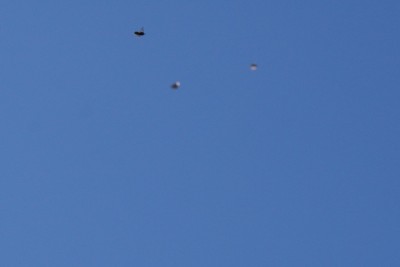
- 3 spiralling males
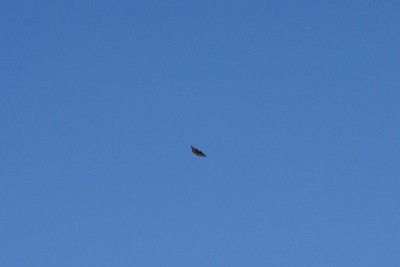
- Male in flight
After walking a transect across the site twice, I came to a count of 5 males, and was unable to locate any eggs. Over the next week or so, I'm sure that there will be further influxes of males and females.
Unfortunately, I'll be away for the first 2 weeks of September, so will miss the mayhem, but I look forward to seeing and hearing about any developments.
Re: Max Anderson
Posted: Tue Aug 09, 2022 12:53 pm
by Max Anderson
Chalkhill and Common Blues
It's been a reasonably good year for both Chalkhill and Common Blues locally. I did notice that there were particularly good numbers of female common blues around over the last few weeks, with a good deal more variability in the upperside than I have experienced in the past 3 or 4 years. I'm lucky to have some close sites, which provide reasonable population of both species, and some exceptional sites for Chalkhills in particular, slightly further afield.
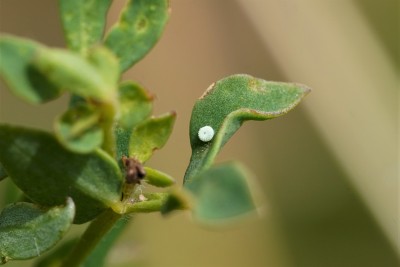
- Common Blue ova
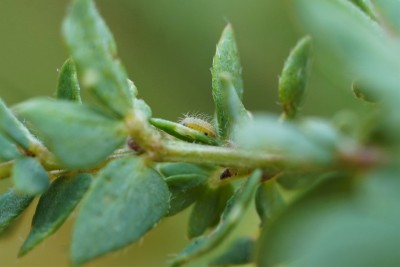
- Common Blue L1 larva
My local site yeilded only 2 female Chalkhill Blues this year, with perhaps 6 or 7 males. Despite this, the eggs haven't been too challenging to find. A quick trip to Friston gallops proved to be very fruitful, as anticipated, with several hundred adults on the wing in late July.
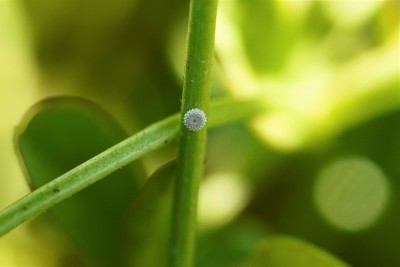
- Chalkhill Blue ova
Re: Max Anderson
Posted: Thu Aug 11, 2022 3:20 pm
by David M
Fabulous array of reports, Max. I'm impressed with how well you can take aerial images of such tiny butterflies as Silver Studded Blues.
You're right about the LTB flight-pattern. It's a bit Hairstreak-like to me, and the darker shade of blue suffusion certainly lets you know you've seen something different when you stumble across one.
Re: Max Anderson
Posted: Thu Aug 11, 2022 6:37 pm
by bugboy
Great to bump into you this afternoon Max on what was both an enjoyable and frustrating few hours in equal measures. Only another quick flyby after you left. Most likely see you again in about 4 weeks time if not before.
Re: Max Anderson
Posted: Thu Aug 11, 2022 6:51 pm
by Wurzel
Lovely set of shots Max - they seem to be turning up more regularly now - what do you think are the chances of them reaching further west in subsequent years? Or will they continue to make landfall here in greater numbers?
Have a goodun
Wurzel
Re: Max Anderson
Posted: Sat Aug 13, 2022 7:16 pm
by Max Anderson
Thanks all,
Great to meet you too Bugboy - looking forward to seeing you again in the near future!
Cheers Wurzel - I think you're right. It's pretty clear that the LTB is a regular migrant now. They do appear further west, but just not quite in the numbers that are seen here in the Southeast. I'm sure that over time, we will see greater numbers in both areas, but I wouldn't ever expect there to be as many seen in the soutwest as there will be in Sussex and Kent, purely because of how much closer they are to mainland Europe. As you know though, it's not always as simple as that, and exceptional circumstances can drive unpredictable and interesting results now and again. Predicting the occurrence of migrants is something of great interest, but I've still got a lot to learn, with many questions that need to be addressed.
Re: Max Anderson
Posted: Mon Aug 15, 2022 6:35 pm
by Max Anderson
Long-tailed Blues are slowly increasing in numbers in Sussex, with what looks like a few first British-born adults already on the wing.
On a separate note, I’ve also seen 6 brown hairstreak females across 3 of my local sites. Still some time before the peak will be reached, but looking like it should be a reasonable year. At some of my sites, the blackthorn is wilting and has been dropping leaves for some time already. I do wonder whether the condition of blackthorn will impact egg laying habits.
I was also fortunate to find a Small Blue caterpillar making its way down to the base of the kidney vetch. It was nestling itself amongst the leaf stems and I suspect this is where they pupate, as I’ve been unable to find any pupae elsewhere on the plant.
Re: Max Anderson
Posted: Mon Aug 15, 2022 7:24 pm
by Wurzel
Cheers for the info Max - I'll have to try and get down to the coast a bit more and start checking out the pea plants

More cracking shots although the second one seems to be misnamed! More of a NTB (Non-tailed Blue)


Have a goodun
Wurzel
Re: Max Anderson
Posted: Tue Aug 16, 2022 7:14 am
by trevor
Some great encounters with the ' Blues ' recently, Max.
I daresay we will meet on a certain hill before long.
Interesting reports as usual,
Trevor.
Re: Max Anderson
Posted: Thu Aug 18, 2022 7:29 am
by David M
Max Anderson wrote: ↑Mon Aug 15, 2022 6:35 pmLong-tailed Blues are slowly increasing in numbers in Sussex, with what looks like a few first British-born adults already on the wing.
Great news, Max. We've got Clouded Yellows in south Wales at the moment - I wonder if any Long Tailed Blues might make it this far west this year?
Re: Max Anderson
Posted: Tue Nov 22, 2022 5:47 pm
by Max Anderson
Silver-studded blue
I was out on the Pebblebed Heaths in East Devon chatting with some transect walkers about the status of the SSB populations in the area. There has been a lot of data collection going on over quite a long period of time, which means that they should be able to establish some idea of how scraping and other management approaches are impacting the populations on a local and landscape scale. The consensus seems to be that the SSB’s are pretty well distributed throughout the area, though appear to be fluctuating in numbers, with some variable responses to scraping. Hopefully some of the data will be analysed soon.
While we were out and about, I wanted to have a shot at looking for eggs. The literature suggests that the majority of eggs are laid pretty much anywhere within 10cm of the ground, either on the foodplant, surrounding vegetation or substrate, typically in close proximity to ants. After speaking with some others about this, they had also made reference to them occasionally laying eggs on Bracken, with the suggestion that this is attributed to the presence of extrafloral nectaries, which will attract ants. It’s makes sense for any given egg-laying strategy to persist if it maximises the chances of the larvae being located by ants.
Searching for eggs on Bracken was very successful in areas that were known to have hosted higher numbers of adults in the summer. They’re quite conspicuous, as you’ll see below. We found around 20 eggs on Bracken in 30 minutes, but were unable to locate any elsewhere. The eggs laid will have been over 30cm above the ground, and all were found on the underside of Bracken leaflets.